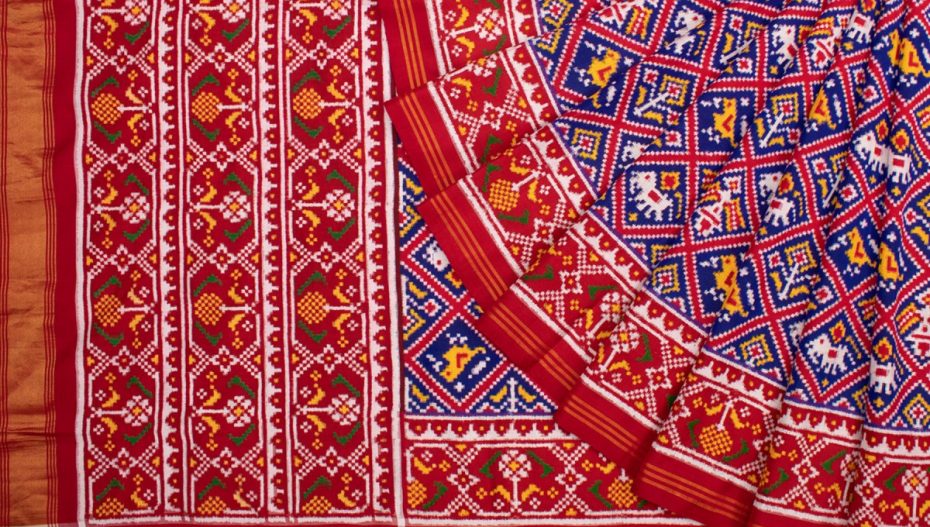‘Chhelaji re mare hatu Patan thi patola, mongha lavjo ema ruda re moraliya chitravjo Patan thi patola’ (a woman urges her husband who is off to Patan to bring her the coveted Patola sari from there). The unfading charm of Gujarat’s famous weave Patola is reflected in the Gujarati folk song penned by poet Avinash Vyas decades ago.
Considered an heirloom buy owing to the one-of-a-kind designs and painstaking weaving technique, an authentic Patola is as intricate as it is impactful. Dressed in a 60-year-old red Patola, Deepal Trivedi of Vibes of India speaks about her favourite handloom. She delves into the history, present and future of this weave.
Excerpts from the conversation:
The history
During the 11th century, around 700 families from Jalna city were invited to Patan – then the capital of Gujarat – by Kumarpal Solanki, the king of Patan. These weavers were mostly from the Salvi family and migrated to Patan due to family issues in Jalna. They were then joined by weavers from Karnataka, and eventually developed and evolved the Patola sari.
Historically, double ikat textiles are made only in four places in the world: Bali (Indonesia), Okinawa island (Japan), Pochampalli (Telangana), and Patan. Around 600 years ago, burial clothes in the Philippines resembled Patola.
Both the warp and the weft thread are dyed in double ikat Patolas. This means the weaving process requires a lot of concentration and precision. Even a tiny mistake can ruin the entire design. Because of the unique technique, Patola sarees are reversible. Often, even the weaver cannot tell the difference. They are also quite popular for their vibrant colours and geometric motifs.
Ageless and priceless
Patolas never age. They are considered heirlooms and are passed on from one generation to another. They are considered auspicious and are often worn by women during special occasions like a wedding. Patolas have formed an essential part of the stridhan that a bride usually gets from her home. Most Gujarati women have at least one Patola in their collection. Earlier Patola was considered a status symbol, owned and flaunted by aristocrats and royals.
Some Patolas take over eight months to finish. Apart from Patan’s Patolas; one can also find Patolas in Rajkot; the Pochampally sari from Telangana is also similar. Only an expert can determine if they are double or single ikat. Double ikat Patan Patolas are far more expensive as they are touted to be the most complicated textile design in the world.
Natural dyes and motifs
Patola saris make use of natural dyes like indigo, turmeric, kesudo, pomegranate skin, henna, marigold flower, etc., in the colouring process. This is the reason the colors don’t fade even after decades.
The weavers originally belonged to the Jain community. Instead of living creatures like animals or birds, they appreciate geometrical shapes. Therefore, you find these shapes dominating Patolas. Since the Muslim community doesn’t worship idols, when it comes to clothing, they appreciate floral designs. For all these reasons, floral and geometrical designs were included in Patolas.
The present situation
Of the 700 families that migrated to Patan, only three of them still create Patolas. One of the prime reasons for this is the fact that this weaving technique is only passed on to the sons and male members of the family. Thus, the craft missed out on the major contribution it would have received from women.
Right now, students from the National Institute of Design (NID) and others from several institutes in Europe are learning and reviving the art form to ensure it doesn’t become extinct.
Patan Patola Heritage Museum
Seeing the gradual but constant decline in the Patola weaving tradition, the Salvi family decided to archive the weaving process and safeguard its heritage. That’s how the Patan Patola Heritage Museum came into existence in 2014. This private museum preserves the history of the handloom.
Finally, the BJP government, and especially Smriti Irani, has also done incredible work in reviving this handloom. Irani’s #IWearHandloom campaign was one of the first events to rekindle interest in the Patola weave. The Geographical Indicator (GI) tag has also added to the authenticity of Patola.












